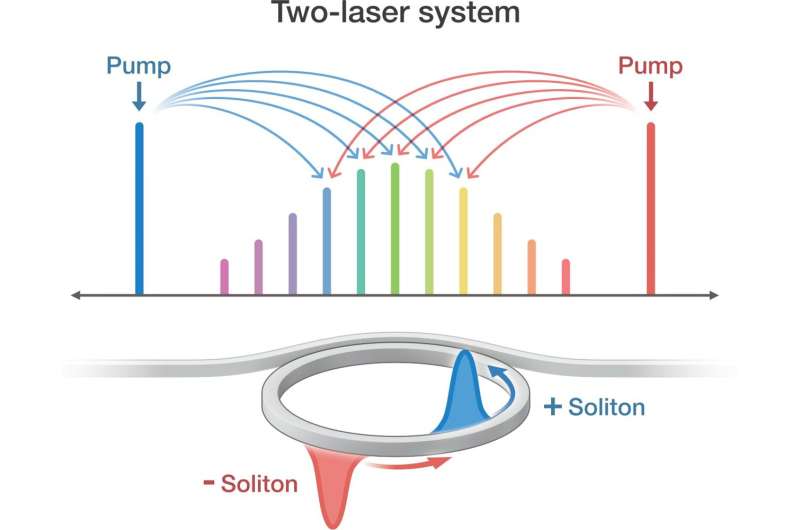Top: In the new comb system, two pump lasers shape each tooth, producing a frequency comb that could theoretically be sharper than a comb produced by a single laser. Bottom: The interaction between the two lasers randomly produces solitons in two different phases, which can be understood as a soliton pulse having either a positive or negative sign. Credit: S. Kelley/NIST
Chip-based devices known as frequency combs, which measure the frequency of light waves with unparalleled precision, have revolutionized timekeeping, the detection of planets outside of our solar system and high-speed optical communication.
Now, scientists at the National Institute of Standards and Technology (NIST) and their collaborators have developed a new way of creating the combs that promises to boost their already exquisite accuracy and allow them to measure light over a range of frequencies that was previously inaccessible. The extended range will enable frequency combs to probe cells and other biological material.
The researchers describe their work in Nature Photonics. The team includes François Leo and his colleagues from the Université Libre de Bruxelles, Belgium, Julien Fatome of the Université de Bourgogne in Dijon, France, and scientists from the Joint Quantum Institute, a research partnership between NIST and the University of Maryland.
The new devices, which are fabricated on a small glass chip, operate in a fundamentally different way from previous chip-based frequency combs, also known as microcombs.
A frequency comb acts as a ruler for light. Just as the uniformly-spaced tick marks on an ordinary ruler measure the length of objects, the uniformly-spaced frequency spikes on a microcomb measure the oscillations, or frequencies, of light waves.
Researchers typically employ three elements to build a microcomb: a single laser, known as the pump laser; a tiny ring-shaped resonator, the most important element; and a miniature waveguide that transports light between the two. Laser light that is injected into the waveguide enters the resonator and races around the ring. By carefully adjusting the frequency of the laser, the light within the ring can become a soliton—a solitary wave pulse that preserves its shape as it moves.
Each time the soliton completes one round trip around the ring, a portion of the pulse splits off and enters the waveguide. Soon, an entire train of the narrow pulses--which resemble spikes--fills the waveguide, with each spike separated in time by the same fixed interval, the time it took for the soliton to complete one lap. The spikes correspond to a single set of evenly spaced frequencies and form the tick marks, or "teeth," of the frequency comb.
This method of generating a microcomb, though effective, can only produce combs with a range of frequencies centered on the frequency of the pump laser. To overcome that limitation, NIST researchers Grégory Moille and Kartik Srinivasan, working with an international team of researchers led by Miro Erkintalo of the University of Auckland in New Zealand and the Dodd-Walls Centre for Photonic and Quantum Technologies, theoretically predicted and then experimentally demonstrated a new process for producing a soliton microcomb.
Instead of employing a single laser, the new method uses two pump lasers, each of which emits light at a different frequency. The complex interaction between the two frequencies produces a soliton whose central frequency lies exactly in between the two laser colors.
The method allows scientists to generate combs with novel properties in a frequency range that is no longer limited by pump lasers. By generating combs that span a different set of frequencies than the injected pump laser, the devices could, for example, allow scientists to study the composition of biological compounds.
More information: Grégory Moille et al, Parametrically driven pure-Kerr temporal solitons in a chip-integrated microcavity, Nature Photonics (2024). DOI: 10.1038/s41566-024-01401-6
Provided by National Institute of Standards and Technology
This story is republished courtesy of NIST. Read the original story here.
























